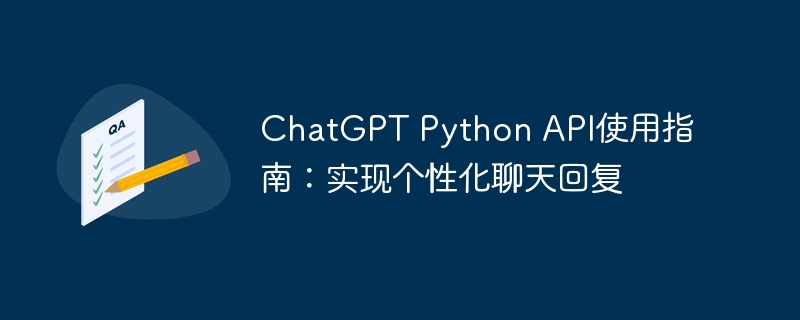

ChatGPT Python API Usage Guide: Implementing Personalized Chat Replies
Introduction:
ChatGPT is a powerful natural language processing model of OpenAI. Can be used to implement human-computer dialogue systems. In this article, I will introduce you how to use ChatGPT through the Python API and give specific code examples to help you implement personalized chat responses.
1. Preparation:
Before you start, you need to ensure that your system has the OpenAI library installed. You can install it through the following command:
pip install openai
Then, you An OpenAI account is required and a valid API key is required to access ChatGPT.
2. Chat using Python API:
After obtaining the API key, we can use Python API to chat. First, we need to import the required libraries:
import openai
Next, we need to set up the API key, which can be done by:
openai.api_key = 'YOUR_API_KEY'
Then, we can define a function for chat interaction :
def chatGPT(query):
response = openai.Completion.create(
engine="text-davinci-003",
prompt=query,
max_tokens=50,
temperature=0.6,
n=1,
stop=None,
frequency_penalty=0.0,
presence_penalty=0.0
)
return response.choices[0].text.strip()In the above code, we use the text-davinci-003 engine and set some parameters to adjust the quality and style of the reply. You can adjust it to suit your needs.
Finally, we can chat by calling the chatGPT function:
while True:
query = input("您:")
if query == "退出":
break
response = chatGPT(query)
print("ChatGPT:", response)This code will receive the user's input in a loop and output the ChatGPT reply until the user enters "exit".
3. Example application scenarios:
ChatGPT can be applied to many scenarios, such as customer service robots, intelligent assistants, etc. The following is a simple example to show how to implement a weather query robot:
def chatGPT_weather(query):
if "天气" in query:
location = query.replace("天气", "").strip()
response = "正在查询{}的天气...".format(location) # 调用天气相关API
else:
response = chatGPT(query)
return response
while True:
query = input("您:")
if query == "退出":
break
response = chatGPT_weather(query)
print("ChatGPT:", response)Through the above code, we define a function named chatGPT_weather to handle weather-related issues. When the question entered by the user contains "weather", we will extract the location information and call the corresponding weather query API to obtain the weather information. If the question entered by the user does not involve the weather, ChatGPT is directly called to reply.
Conclusion:
Through OpenAI’s ChatGPT and Python API, we can easily implement personalized chat responses and customize our own chat robot according to needs. I hope this guide was helpful and I wish you success in your development process!
The above is the detailed content of ChatGPT Python API Usage Guide: Implementing Personalized Chat Replies. For more information, please follow other related articles on the PHP Chinese website!




